Nobody Is Happy With the Federal Grazing Program
Lauren Leffer
Sun, January 29, 2023
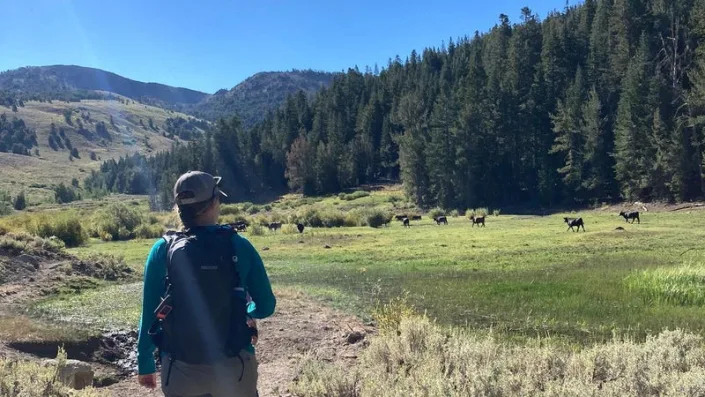
Rachel Sadowski, a conservation researcher at the San Diego Botanic Garden, walks on a National Forest trail facing a herd of cattle.
At the first National Forest site we visited in California’s remote Modoc Plateau, nearly every plant had been chewed on by cattle. The botanists, there to track down and collect seeds from rare plants, pointed out the soil erosion from stomping hooves. The cow pies were everywhere, unavoidable on the steep roadside slope, and they crunched or squished under our boots. The seeds we had come to collect, from a delphinium only known to exist in a handful of places in the state (though more common elsewhere), were mostly gone before the botanists could preserve them—disappeared in the digestive tracts of hungry ungulates. These plants, which just a few weeks ago had been flush with purple flowers, and which the botanists had thought would now be covered in seed pods, were instead largely gnawed to stubby stalks. At the base of the hill along the river below, we could see the offending cattle. And even before we saw them, we could hear their lowing.
The cows are innocent enough, of course. But they’re unknowingly at the center of an ongoing battle between ranchers, conservationists, and the federal government. The conflict, which spans more than a century, is set to get even more heated this year, with the forthcoming release of new Bureau of Land Management rules on cattle grazing and a recent legal challenge filed by environmental groups. The outcome could permanently alter the western U.S.’s public lands.
At the field site, the botanists collected what they could of the remaining seed pods in small yellow envelopes. Christa Horn, the trip coordinator and a plant conservation researcher at the San Diego Zoo, pulled up the state records for the delphinium at our location on her field tablet. Cattle damage had been noted at this site all the way back in 2010. This time, before we moved on to the next place, Horn submitted a note to the purple plant’s digital file. She indicated that cattle damage wasn’t just present at the site but that it posed a real threat to the flower’s survival there.
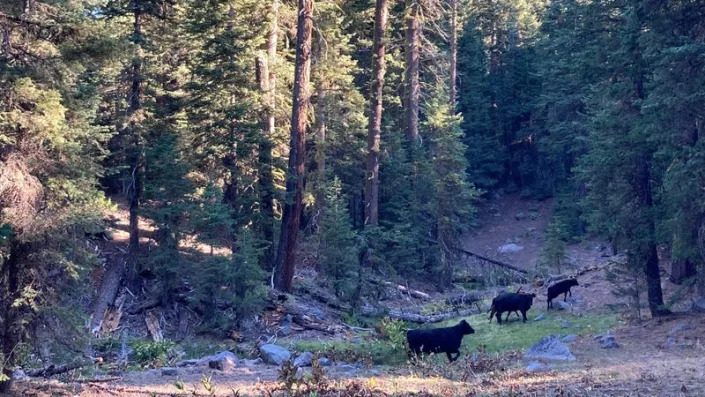
Cattle were just about everywhere in California’s Modoc National Forest, even here in a designated wilderness area.
It’s a pattern that would repeat over the five days in August 2022 that I spent with the researchers: cows where we weren’t expecting them to be, trampled soil, poop piles, and plants cut down before their seeds could mature into the next generation. Every place we visited was on public, ostensibly protected land—National Forest or Bureau of Land Management territory. And at nearly every site, we encountered cattle.
Horn and her colleagues took it in stride. They were careful not to make any sweeping declarations about how the health of the overall plant populations were or weren’t being affected by the presence of cattle. Cows have been grazed on these lands for more than a century, and at least the plants they were out to collect have survived in that time (albeit in small pockets), pointed out Tobin Weatherson, another San Diego Zoo plant conservationist. The plants are persisting, but the damage in front of us was hard to ignore.
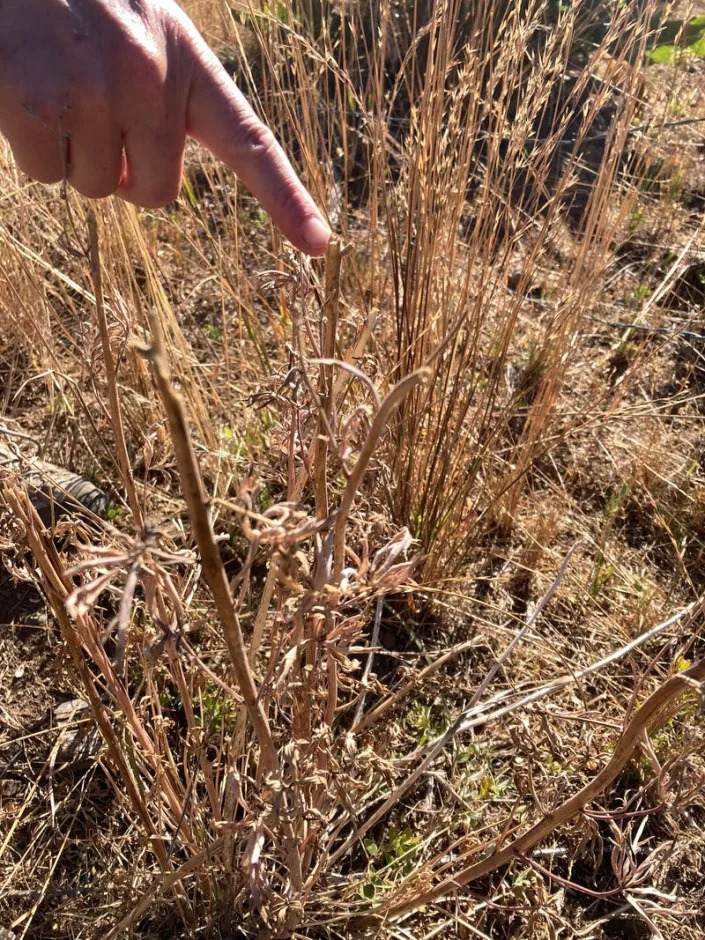
Photo of Hand pointing at plant
A botanist points out where a plant has clearly been grazed. This delphinium is rare in California, and the researchers were trying to collect enough seeds to bank, to ensure the species’ conservation in the state. However, specimens like this one had been munched on by cattle before the seeds could mature and be collected.
It’s indisputable that cattle shape the landscape of the American West, yet whether or not they should be allowed to is a perennially touchy issue. As Horn put it, “people like things the way they’ve always been,” or at least the way they think they’ve always been.
Cattle aren’t native to the U.S. Though bison used to roam in many areas of the country, domestic cows are a different animal, with their own specific quirks, dietary preferences, and movements. For instance, they are thirstier than bison and so spend much more time disturbing the riparian areas along streams and rivers, which also happen to be home to unique and often already imperiled communities of other animals and plants. For plant conservationists like Horn and Weatherson, the cattle are just one facet of a slew of human impacts piled onto the ecosystem. While for ranchers, the cattle represent an entire way of life and a right to the land and its resources. Yet even for the ranchers, the current system is broken.
Cattle grazing is the single largest commercial use of public lands in the western U.S.—more than mining, forestry, or other types of agriculture. About 85% of public lands, or some 250 million acres in the West, are grazed by livestock (mostly cattle), and most of that land is managed by the Forest Service or the BLM. Such grazing has been officially sanctioned since the Taylor Grazing Act of 1934. Prior to that, grazing was entirely unregulated. Without management, grazing became overgrazing, and grassland became wasteland, especially amid the widespread southwestern drought of the 1930s. Overgrazing was one of the primary contributing factors of the Dust Bowl, and the Dust Bowl spurred the Taylor Act. The federal government realized some management was necessary to prevent systemic agricultural collapse from repeating itself.
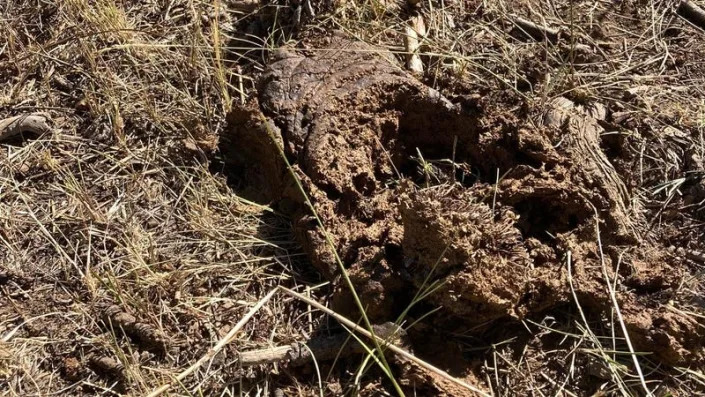
One of many cow pies. It was nearly impossible to avoid stepping in the cattle evidence left behind.
Since 1934, some aspects of the grazing program have been updated, but the changes haven’t kept up with our scientific understanding of land management, ecological health, or climate. And the consequences are being felt by people, not just plants. Ranchers are struggling to keep cattle alive in a shifting ecosystem. Invasive species have become fire-starting nuisances spread, in part, by cattle. An overabundance of cows may be exacerbating water shortages and California’s persistent drought. And public lands are far from the pristine wildernesses recreators seek out. In its current form, the grazing program isn’t working, and it’s not sustainable—not for ecologists, conservationists, federal workers, ranchers, or even the cows.
Now, these cumulative and long-simmering tensions over whether and how to graze cattle on public lands are coming to a head. For the first time in decades, the Bureau of Land Management is set to present new rules on livestock management. The federal agency is planning to release a draft for the updated guide early in 2023. Stakeholders remain skeptical the update will address the multitude of difficulties with the current public grazing program, but any changes would signal a big shift from the stagnation of past years. Additionally, the Center for Biological Diversity, a nonprofit conservation advocacy group, is suing the BLM over the destruction the organization says cattle grazing causes to plants and the landscape, according to a 60-day notice of intent filed in early January. What has long been a taboo issue, too thorny to navigate for federal regulators, is set to be a conversation that defines the next few months.
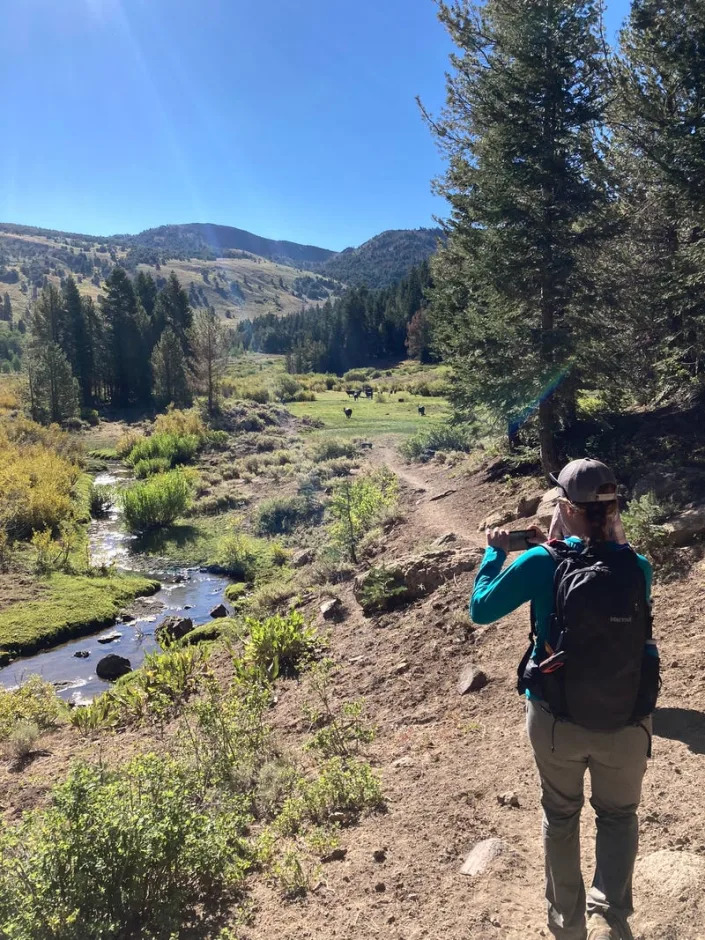
Photo of person and landscape
Rachel Sadowski, a conservation researcher at the San Diego Botanic Garden, documents a herd of cattle in the hike up to a rare plant collection site.
So what are the problems, and what needs to change? For starters, the current cattle program is deeply under-resourced, said Chandra Rosenthal in a video interview with Gizmodo. Rosenthal is the head of the Rocky Mountain office of the nonprofit group Public Employees for Environmental Responsibility (PEER), which provides legal and other support for current and former public employees. The BLM is supposed to track the health of every parcel of rangeland it allots to ranchers, Rosenthal said. Yet through PEER’s own analysis (developed by a former BLM subcontractor), the nonprofit found that the Bureau hasn’t recorded any monitoring data on about 28% of that land. And of the land it had assessed, the BLM noted about half failed to meet its own Land Health Standards, according to PEER’s 2020 review. In 72% of those failures, covering about 40 million acres of land, the BLM indicated livestock overgrazing was a central factor. “We think that the program is really understaffed,” said Rosenthal, who said she and PEER have spoken with numerous past and present workers at the Bureau concerned that the land they oversee is in worse condition than it was when they began their jobs. “There’s a lot of dissatisfaction in those positions,” she added.
PEER opted to create its rangeland health map because the data from the BLM wasn’t centralized or analyzed within the agency itself, Rosenthal said. “Different field offices have different standards for the way they do things,” she added. So, in order to better understand the scope of the problem for federal employees, PEER had to put together its own database. But there were still gaps. “We’ve totally tried to figure out the total number of cattle,” Rosenthal said—but PEER couldn’t. Parts of the data were incomplete, outdated, or unreliable. “It’s crazy,” she added. As a result, it’s difficult to know if there are more or fewer heads of cattle on the landscape now versus a decade ago. The BLM does publish annual land use reports, which track the number of authorizations issued and the amount of grazing material authorized to be eaten, but not the number of animals. Researcher estimates put the number somewhere around 1.5 million cattle on BLM land, not including the rangelands managed by the Forest Service.
Chris Christofferson, the forest supervisor for Modoc National Forest, told Gizmodo in a phone call that the U.S. Forest Service also doesn’t have a single number on the livestock grazing its land. In California, he believes the numbers of cows on the landscape are declining, in accordance with drought restrictions, but he couldn’t point me to public numbers demonstrating that. Christofferson’s account echoed Rosenthal’s perspective, that the public grazing program doesn’t have the funding or staffing it needs, and that in recent years and federal administrations the problem has worsened.
In Modoc, where those rare purple delphiniums had been gnawed to nothing, Christoffersan said that once, there were eight staff solely responsible for monitoring grazing; then, about 10 years ago, it was cut to four people. Then it went from four to just three staff, meant to be managing 1.7 million acres of rangeland.
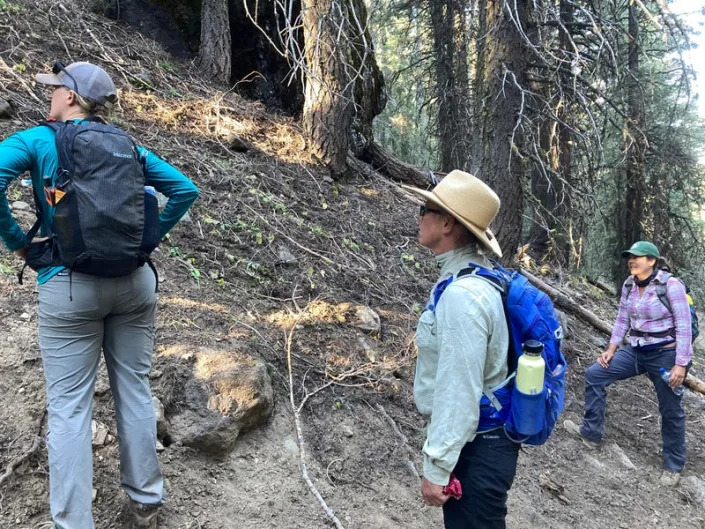
Photo of three people in woods
Botanists Rachel Sadowski, Liz Bittner, and Christa Horn survey cattle damage on an eroded slope where they expected to be able to collect rare plant seeds.
One possible part of the budget issue often cited by environmental advocates: both the Forest Service and the BLM charge ranchers the same fees to graze livestock on public land as they have since 1986. By some estimates, the federal fees are 15 times less than what private landowners charge, effectively offering ranchers an enormous federal subsidy. Those meager fees don’t necessarily end up supporting land management. In certain unique cases, local jurisdictions have set up their grazing fees to go back toward monitoring and maintenance, but Christofferson described this more as the exception than the rule.
Before he began in his role at the Forest Service, Christofferson was a botanist and ecologist. In his view, the relationship between cattle and land health is complicated. “It’s really site specific, timing, and intensity specific,” he said, explaining that some research has shown cattle grazing can benefit certain plant communities reliant on some level of disturbance to flourish. For instance, he pointed me to one 2017 study of grazing in vernal pool habitats in northeast California, in which researchers found that excluding cattle over years led to a lower diversity of annual plants (though the findings weren’t significant at every spatial scale). On the other hand, Christofferson admitted that cattle grazing always comes with the possibility of big negative impacts, “because you’ve got some big animals out there that weigh a lot. And if they are not managed correctly, they can do a lot of damage in a short amount of time.”
In the aftermath of the Biden Administration’s $1 trillion infrastructure bill, Christofferson says his office has been hiring once again. The 2021 legislation included a large chunk of funding for public lands, and he’s already seeing a positive effect that’s left him feeling more optimistic.
Yet in some environments, all the staffing and funding in the world wouldn’t be enough to make grazing sustainable, said Chris Bugbee, an ecologist and conservation advocate for the Center for Biological Diversity, in a phone call with Gizmodo. Bugbee is based in Arizona, and in the Southwest desert, he said, cattle have no place. There, the cows decimate streamside vegetation, spread invasive species like cheatgrass and medusahead, widen and contaminate waterways with their stomping and waste, and compact the already drought-stricken soil, making it even harder for water to infiltrate, according to Bugbee. “Cows are exacerbating the effects of climate change,” he said. Because of the drought in the Southwest, “native plants are already stressed from that alone. Often when you add cows to that, that’s really like the nail in the coffin.”
Under federal management guidelines, the number of livestock is supposed to be limited on public lands during drought periods, but Bugbee said that’s not happening nearly to the extent it should be. He described a 2002 incident in which all of the livestock were pulled off of the grazing parcels in Tonto National Forest during a period of severe drought. The decision “caused a huge backlash. I mean, people lost their jobs over that,” said Bugbee. And, as a result, he’s skeptical that such drastic (though in his view, necessary) measures are likely to happen again. To him, there’s an inherent conflict of interest in the federal agencies’ management. “The role of the range conservationists is to keep cattle on the ground. That’s their interest. That’s their whole job. So that’s a pretty biased system.”
In some cases, the livestock suffer the consequences of ecosystem failure directly. Both Bugbee and Rosenthal of PEER said they’ve seen animals starving and dying on denuded land. Plus, as wildfires increase in severity and size across the West, more and more animals are becoming casualties of burns. Dave Daley, a rancher in Butte County, California and a former president of the California Cattleman’s Association, lost most of his cattle herd in the 2020 Bear Fire, as he described to Gizmodo in a phone interview. Climate change is contributing to the problem of wildfires, but so is fuel buildup from decades of aggressive fire suppression, Daley pointed out. From his perspective, the solution is more grazing, not less. “I think, actually, grazing can be used to heal the landscape.” Similarly to prescribed fires, cattle reduce the amount of vegetation that could otherwise fuel megafires, pointed out Daley. And indeed, some research supports the idea that cattle can help minimize severe wildfire risk in certain settings.
But Bugbee disputes that idea. Because of cattle’s propensity to spread fast-growing invasive species, which fuel fires, he described the concept of grazing to manage fire as “getting drunk to cure your hangover.” It’s a short-term approach to a longer-term environmental issue. Plus, “these ecosystems have been grazed heavily for a century and a half, and yet fires are a monumental and worsening problem,” he added.
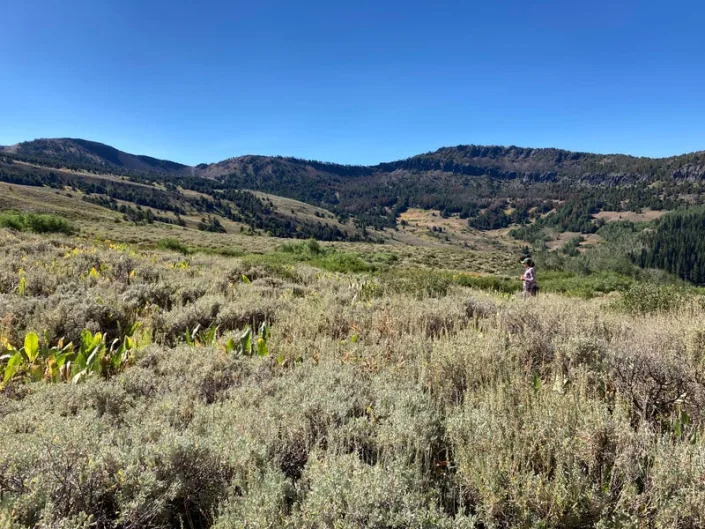
Photo of person standing in mountain meadow
At one of our final locations, the botanists noted much less cattle damage than elsewhere, and Christa Horn (pictured) and her colleagues were finally able to collect the seeds needed to preserve the rare delphinium plant.
All of these issues—of severe drought, out-of-whack fire regimes, invasive species, and biodiversity loss and shifts—are, at least partially, the result of climate change. And cattle contribute to climate change in a big way. Through their digestive processes, livestock are responsible for 27% of U.S. methane emissions, and methane is about 25 times more heat-trapping than carbon dioxide in the atmosphere. One 2022 study estimated that livestock grazing on U.S. public lands alone contributes the equivalent of 12.4 teragrams of CO2 (or 12,400,000 metric tons) every year—equivalent to more than 2.6 million cars’ annual emissions. Though the beef industry would like us to believe otherwise, there is no getting around the climate consequences of cattle. Through fossil fuel extraction alone, federal land actually produces more greenhouse gas than it absorbs, according to a 2018 USGS analysis. And cattle grazing tips the balance even farther from where we need it to be.
Yet there is still time for change. And, for the plants, all is not yet lost.
On one of my last days with the botanists, the seed collection sites we’re checking are a long hike into a designated wilderness area. The first location, relatively early on in the miles-long trek, has been decimated by cows. The soil is trampled and rutted, so much so that the scientists opt not to look around much and disturb it any further, for fear of adding erosion. The few plants we find still clinging to life in the tumbled dirt have no seeds on them, and the researchers hypothesize that the plants self-aborted their seeds to conserve resources. The site doesn’t bode well for points farther on, but we truck ahead up the trail anyway, climbing thousands of feet in elevation to reach a second population of that same blue-ish purplish delphinium that the botanists couldn’t collect enough of on the first day.
And somehow, when we finally get to the open meadow, in a bowl surrounded by ridgelines, the delphinium are there, with their seeds intact. In fact, there are more than expected—enough to make up for the lack at that first roadside hill. It’s a clear win for the botanists, relieved to have something to show for the seven or so miles of hiking, and also for the plants, which have made it to another season. The collected seeds, destined for banks around the state of California, are meant to be an insurance policy (against climate change, invasive species, and yes, cattle) but one that, for another year at least, won’t need to be cashed in.
Gizmodo
No comments:
Post a Comment